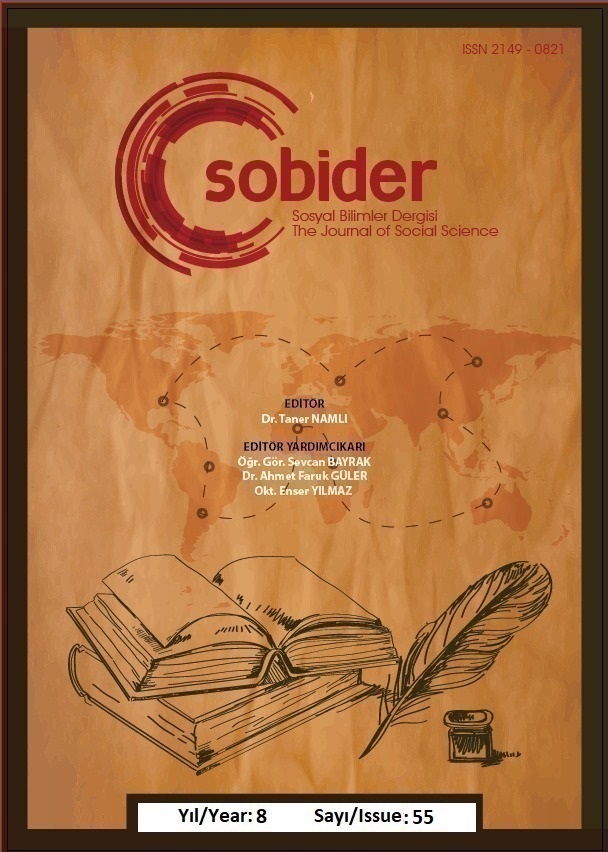TİRE MÜZESİ TERRAKOTTA KOLLEKSİYONU İÇERİSİNDE YER ALAN HERME FİGÜRİNLERİNİN İŞLEVLERİ VE STİL ÖZELLİKLERİ AÇISINDAN DEĞERLENDİRİLMESİ
Author :
Abstract
Hermes, Yunan Pantheonu’nun en sevilen ve en hareketli tanrılarından birisi olarak kabul edilmektedir. Hermes’in, kurnaz olduğu kadar kötülüklerden koruyan, kötülükleri engelleyen özellikleri de bulunmaktadır. Erken dönemlerde yolcuları koruması, onların yollarını bulabilmeleri için yol kenarlarına yığılan taşlar zaman içerisinde, ortasında phallus olan dörtgen bir sütunun üzerindeki Hermes başından oluşan ve Herme adı verilen heykellere dönüşmüştür. Yunan toplumunda, İ.Ö.520 yılında itibaren Atina’da yolcuları koruması ve sınırları belirlemesi amacı ile üretilmeye başlanmıştır.
Hermeler kısa bir süre içerisinde sadece yolcuları koruması için değil Hermes’in tüm epithetleri ile ilgili olarak farklı yerlerde kullanılmaya başlanmıştır. Kapıları koruyan Hermes Propylaos, agoralarda ticarete hile karıştırılmasın diye Hermes Agorios, atletlerin koruyucusu olarak Hermes Enagaios epithetlerine karşılık gelen Hermeler yapılmaya başlanmıştır.
Keywords
Abstract
Hermes is regarded as one of the most beloved and active gods of the Greek Pantheon. As well as being cunning, Hermes also has features that protect from evil and prevent evil. In the early periods, the stones piled up on the roadsides to protect the travelers and to find their way, over time, turned into statues called Herme, consisting of the head of Hermes on a rectangular column with a phallus in the middle. In Greek society, it has been produced in Athens since 520 BC with the aim of protecting the passengers and determining the borders.
In a short time, Hermes began to be used in different places, not only for the protection of passengers, but also for all the epithets of Hermes. Hermes Propylaos protecting the gates, Hermes Agorios in order not to cheat the trade in the agoras, Hermes corresponding to the Hermes Enagaios epithets as the protector of the athletes started to be made.
Keywords
- Besques Simon, Catalogue Raisonné Des Fıgurines Et Reliefs En Terre Cuite Grecs Et Romains II Myrina, Paris, 1963. Volume I-II.
- Besques Molllard Simon, Catalogue Raisonné des Fıgurines et Reliefs en Terre Cuite Grecs Etrusques et Romains III Époques Hellénistique et Romaine Gréce et Asie Mineure, Paris,1971. Text-Plate
- Burkert Walter, Ancient Mystery Cult, Harvard University Press,1987.
- Burkert Walter, Greek Religion, Çev.: John Raffan, Harvard University Press, 2003.
- Francis Jane E., “Re-writing Attributions: Alkamenes and Hermes Propylaios”, Stephanos: Studies in Honor of B. S. Ridgway, Phidelphia 1998.
- Hermary A., “À propos de l'Hermès Propylaios de Délos”, BCH, 103, 1979.
- Harrison Evelyn B., “Archaic and Archaistic Sculpture”, Agora XI, Princeton 1965.
- Larson J., Ancient Greek Cults, New York 2007.
- Nilsson M., Greek Folk Religion, New York,1961.
- Özgan R., “Alkamenes’in Hermes Propylaiosu Üzerine Düşünceler”, TürkArkDerg. XXXI, Ankara 1997, s. 158 vd.
- Protznann H., “Realismus und Idealitat in Spatklassik und Frühhellenismus” JDI 92, 1977, pp:169-203
- Ridgway Sismondo Brunilde; Fourth-Century Styles in Greek Sculpture, The University Of Wisconsin Press, 1997.
- Ridgway Sismondo Brunilde;Hellenistic Sculpture I; The Styles of Ca. 331-200 B.C., The University of Wisconsin Press, 2001.
- Ridgway Sismondo Brunilde; Hellenistic Sculpture Iı; The Styles of Ca. 200-100 B.C., The University of Wisconsin Press, 2000.
- Schultz Peter, Early Hellenistic Portraiture, Image, Style, Context, Cambridge University Press, 2007.
- Stewart Andrew, Greek Sculpture an Exploration, Volume I-II, Yale University Press, 1990.
- Thompson Burr Dorothy, Three Centuries of Hellenistic Terracottas I,B and C, Hesperia 23-1, 1954, s:72-107.
- Thompson Burr Dorothy, Three Centuries Hellenistic Terracottas: Part II: The Early Third Century BC. Hesperia 26-2,1957,s:108-12
- Thompson Burr Dorothy, Three Centuries of Hellenistic Terracottas: II.C The Satyr Cistern, Hesperia 31-3, 1962, s:244-262.
- Thompson Burr Dorothy, A Clay Model of an Ephebe, Hesperia 32-1, 1963, s:88-90
- Thompson Burr Dorothy, Three Centuries of Hellenistic Terracottas, Hesperia 35-3,1966,s:252- 267.
- Thompson Burr Dorothy, Troy The Terracotta Figurines of the Hellenistic Period, Princeton University Press,1963.
- Thompson Burr Dorothy, Three Centuries of Hellenistic Terracottas:VII.The Early First Centruy BC., Hesperia 35-1,1966, s:1-19.
- Töpperwein Eva, Terrakotten Von Pergamon, Berlin,1976.
- Von Den Hoff R., Schultz P., Early Hellenistic Portraiture, Edt.: Peter Schultz, in Early Hellenistic Portraiture Image, Style, Context, Cambridge University Press, New York, 2007, pp:1-13.
- Wrede, H. (1972). Spätantike Hermengalerie von Welschbillig, Verlag Walter De Gruyter&Co, Berlin.
- Wrede, H. (1985). Die antike Herme, Phillip von Zabern, Mainz Am Rhein.
- sakalsız bir erkek başı yer almaktadır. Sütunun orta kısmında bir phallos yer almaktadır. Benzerleri: E.Töpperwein, 1976, Taf.52-378; S.Mollard Besques,1971, Pl.122-D580;
- S.Besques, 1963, Pl.144-LY1608 Tarihleme: İ.Ö.2YY sonu – İ.Ö.1 YY
